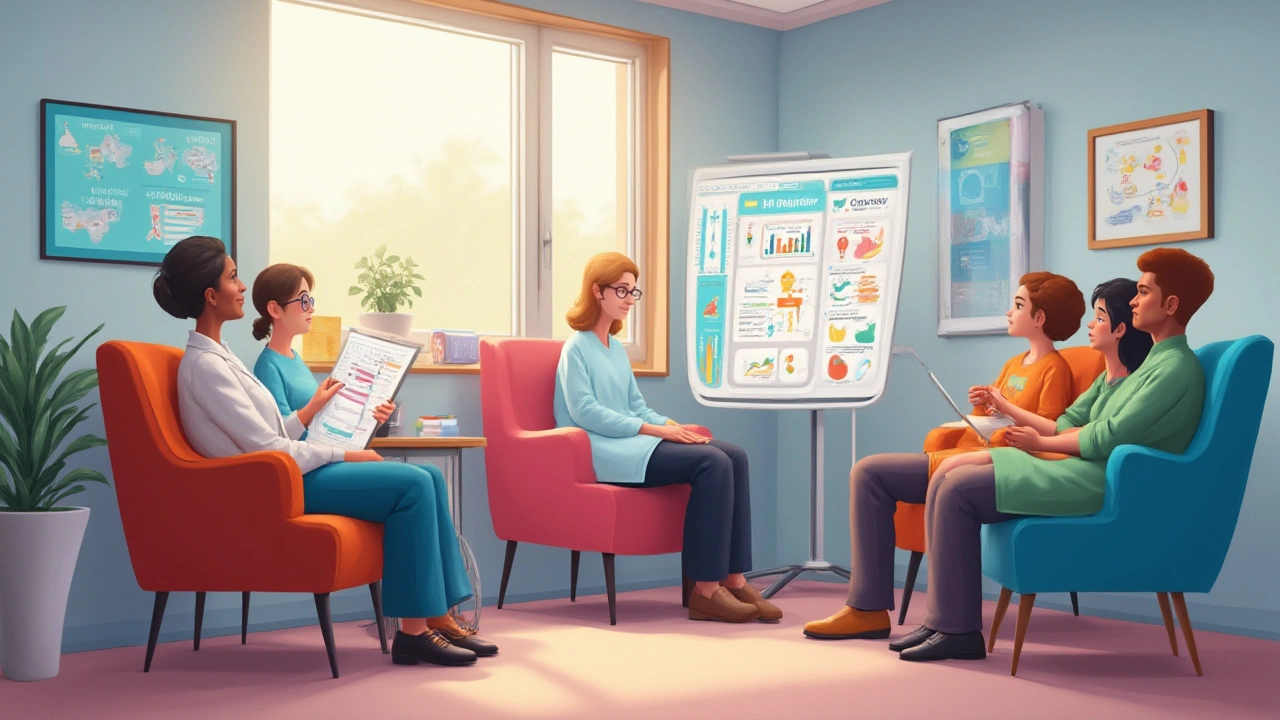You’d be surprised how many folks land in the ER with blood pressure through the roof—only to walk out clutching a fresh prescription for a beta blocker. Sure, beta blockers have been staples for decades. But for people dealing with notorious side effects—especially that dreary, dragging pulse—there’s finally a new playbook. Let’s face it: not everyone’s heart likes being slowed down. Some of us notice that steady beat lagging after only a couple days. The world outside your ribcage shouldn’t dictate your plans—and your pill shouldn’t put you in slo-mo either. So, if you care about energy, brainpower, or even just making it to work without a yawn-fest, you’re in the right place. It’s time to get real about controlling hypertension without the bradycardia.
Why Switch: The Bradycardia Problem
A sluggish pulse sounds innocent, but ask anyone who’s felt their heart sitting at 48 beats per minute. There’s a reason high-level athletes train for years to get there—it isn’t meant to be a side effect of your blood pressure meds. Between the fatigue, dizzy spells, mood dips, and the weird sense your body is running at half-speed, bradycardia can make life feel off. But here’s the catch: not every high blood pressure med comes with this baggage. For years, people stuck with traditional beta blockers because they were just about all anyone prescribed for certain heart risks. But medicine has moved on.
Studies as early as 2004 started hinting that beta blockers, especially older types like atenolol and propranolol, could slow the heart far more than needed—and sometimes did little extra for long-term heart health compared to other blood pressure drugs. Modern guidelines flag this: Beta blockers are now usually reserved for particular patients, like those with a history of heart attacks or arrhythmias. For the rest? Turns out, we have more options. If you’re wondering what’s next or trying out alternatives to beta blockers for hypertension, you’re not alone. The crowd is growing, fast.
Meet the Contenders: ARBs, ACE Inhibitors, SGLT2 Inhibitors
Let’s strip away the mystery from these fancy acronyms. First, ARBs: angiotensin receptor blockers. Valsartan, losartan, candesartan—odds are you’ve heard of at least one. What do they do? Instead of slowing your pulse, these meds gently block a hormone system that tightens blood vessels. Your arteries relax, pressure goes down, but your heart rate barely notices.
ACE inhibitors—cousins of ARBs—work a bit upstream. Think lisinopril, enalapril, ramipril. Instead of just blocking the hormone’s effect, they keep your body from even creating it in the first place. The result? Strong blood pressure drops without those slowed-down heartbeats. If you’re worried about cough, yes, ACE inhibitors can cause that in a small set of people, but ARBs don’t pose the same issue and can be swapped in easily.
Then there’s the new crowd: SGLT2 inhibitors. Originally created for type 2 diabetes—dapagliflozin, empagliflozin—their ability to lower blood sugar was expected, but the real twist was what they did to blood pressure. These meds help your kidneys shed sugar and salt through urine. Less salt, less water in the blood; that means lower pressure, and, again, no slow pulse. One 2023 trial out of Toronto showed patients on SGLT2 inhibitors shed an average of 4-6 mmHg systolic blood pressure—comparable to many traditional medications—without any measurable impact on pulse rate. SGLT2s even seem to protect the heart and kidneys in a way no one saw coming.

Science Speaks: The Benefits Without the Slowdown
Data from the last five years reshaped the hypertension landscape. Take the PARADIGM-HF trial, often cited in cardiology circles. While ARBs and ACE inhibitors were being pitted against each other (and combined in some cases), researchers noticed a common thread: both provided better stroke and heart failure prevention compared to classic beta blockers—and neither triggered bradycardia. Side effect profiles looked favorable, too. The most common gripes? Occasional dizziness starting out, a tickly cough with ACE inhibitors, and for SGLT2 inhibitors, a higher risk of certain UTIs. Not much, considering the alternative of dragging through your day.
Another interesting nugget: SGLT2 inhibitors, though relatively young in the blood pressure world, are now front runners for people with tough-to-treat hypertension—especially if diabetes or early kidney disease are also in the mix. Unlike older diuretics, SGLT2s pull out salt while sparing potassium, which can be a big deal if you want steady muscle energy and fewer doctor visits for electrolyte checks. And, paradoxically, they lower blood pressure not by draining fluid willy-nilly, but with a mechanism that spares your body’s good balance. The EMPA-REG OUTCOME trial even showed fewer cardiovascular deaths with SGLT2 inhibitors—big news for anyone with a family history of heart problems.
Smart Tips: Picking the Right Therapy for You
No two bodies are identical, so choosing the right high blood pressure therapy isn’t as easy as picking a winner from a list. Still, knowing your risk factors makes things easier. If you deal with allergies or a chronic cough, ARBs often take the crown—losartan and valsartan both top national guidelines for “least hassle, most benefit.” Folks with a strong family history of kidney stones or early cardiac disease? ACE inhibitors have more track record in long-term trials, but always mention that tickle-in-the-throat issue if you’re prone.
Trying SGLT2 inhibitors is smart if your blood sugar rides high, you’ve seen even a hint of early kidney problems on lab tests, or you’re swimming against the current with multiple meds that still leave your blood pressure up. The catch: insurance may try to slow you down with authorizations, since these are newer and pricier, but more plans are covering them as evidence piles up.
- Always check your pulse at home before and after starting any new medication—if you see a sudden drop below 55, call your doctor fast (rare, but worth a watch).
- Keep a blood pressure log for three weeks after any switch—docs love real numbers more than “I feel dizzy.”
- Ask about combination pills; today’s market has ARB/diuretic and ACE inhibitor/diuretic blends that cut pill count in half.
- Hydration matters—SGLT2s can leave you a tiny bit drier, especially in hot months. Pour a glass of water at every meal as a habit.
- Watch for any new cough with ACE inhibitors. Most people never notice it, but if it pops up, don’t just shrug—ARBs are waiting in the wings.
- Ask your doc about kidney function tests before and after starting SGLT2 inhibitors; most experts run a baseline, just to be safe.
If you feel yourself tiring of the old playbook—bradycardia, cold fingers, blanked-out workouts—don’t settle. The hypertension field finally has options with real flexibility, and you can swap from beta blocker alternatives to these newer choices without missing a beat. Ask, research, and manage your health like you mean it—the right med is closer than you think.


Scott Dill
July 25, 2025 AT 14:43I was on atenolol for two years and felt like a zombie at work-like my brain was wrapped in cotton. Switched to losartan last year and suddenly I could run without feeling like I was dragging an anchor. No more 50 bpm at 3 PM. Life changed.
Mansi Gupta
July 25, 2025 AT 17:54This is a well-structured and thoughtful overview. I appreciate the emphasis on individualized care and the distinction between beta blockers and newer agents. In my clinical experience in India, access to SGLT2 inhibitors remains limited due to cost, but when available, patient outcomes are markedly improved without the fatigue burden.
Erin Corcoran
July 27, 2025 AT 13:09OMG YES. I was on lisinopril and got that cough so bad I thought I had COVID for months 😅 Switched to valsartan and boom-no cough, no slow heart, and I actually started hiking again. SGLT2s are wild though-my doc said they’re like magic for kidneys too 🤯
shivam mishra
July 28, 2025 AT 14:48As a primary care provider in rural India, I’ve seen this shift firsthand. Beta blockers were the default because they were cheap and familiar. But patients kept coming back with complaints of fatigue, low energy, even depression. Once we started offering ARBs and, where affordable, SGLT2 inhibitors, adherence improved dramatically. One patient, a schoolteacher, said she could finally teach without napping after lunch. That’s the real win-not just BP numbers.
Also, hydration tip? Critical. I tell every patient on SGLT2s: drink water like it’s your job. Especially in summer. Dehydration + these meds = dizziness city. Simple, but overlooked.
And yes, the UTI risk is real but manageable. I tell them to pee after sex, wipe front to back, and avoid douches. No big deal if you’re mindful.
Combination pills? Huge. One pill instead of three? That’s the difference between taking it and forgetting it. I’ve started prescribing losartan/hydrochlorothiazide as first-line for most patients now. Cost-effective, effective, no bradycardia.
And for anyone worried about kidney tests-yes, get a baseline. But if your creatinine stays stable and you’re not diabetic, you’re golden. These drugs are safer than we thought.
Stop accepting bradycardia as ‘normal.’ It’s not. Your heart shouldn’t be medicated into a coma.
John Kane
July 29, 2025 AT 00:52Let me tell you something-I used to think if your BP was down, you were good. But no. If you’re walking around feeling like your body’s on 50% battery, you’re not ‘doing okay,’ you’re just surviving. I’m 47, work in construction, and I used to come home so drained I couldn’t play with my kids. Atenolol made me feel like an old man before my time. Then my cardiologist switched me to candesartan and added a low-dose SGLT2i because I had borderline prediabetes. And man, did that change everything.
I’m not just talking about energy-I’m talking about mental clarity. I could finally focus at meetings. No more ‘what was I saying?’ moments. My wife said I started laughing again. That’s not a side effect-that’s a life upgrade.
And the SGLT2? It’s weird, but I lost 8 pounds without trying. Not because I was dieting, just because my body stopped holding onto salt and water like it was scared of drowning. I didn’t even notice until my jeans fit looser.
People think hypertension meds are just about avoiding strokes. But what about avoiding the slow death of your daily joy? That’s the real cost. And these drugs? They don’t steal your life. They give it back.
I used to think ‘new meds’ meant risky. Turns out, the real risk was staying on the old stuff.
Don’t let your doctor push you into beta blockers just because it’s easy. Push back. Ask for the alternatives. You deserve to feel alive, not just stable.
And if your doc says ‘it’s fine, your BP’s normal’-tell them your pulse is 52 and you can’t climb stairs without stopping. That’s not fine. That’s a sign you’re on the wrong script.
There’s a better way. I found it. You can too.
Arrieta Larsen
July 29, 2025 AT 02:13Hydration tip is spot on. I forgot to drink water one hot week on empagliflozin and ended up in urgent care with dizziness. Lesson learned.
Mike Gordon
July 29, 2025 AT 19:45ARBs over ACE inhibitors if you’ve got a cough history period end of story